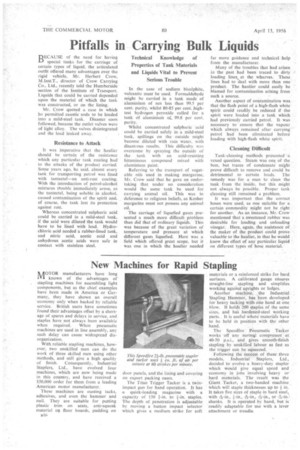Pitfalls in Carrying Bulk Liquids
Page 50

If you've noticed an error in this article please click here to report it so we can fix it.
Technical Knowledge of Properties of Tank Materials and Liquids Vital to Prevent Serious Trouble BECAUSE of the need for having special tanks for the carriage of certain types of liquid, the articulated outfit offered many advantages over the rigid vehicle, Mr. Herbert Crow, M.Inst.T.. director of Crow Carrying Co., Ltd., recently told the Humberside section of the Institute of Transport. Liquids that could be carried depended upon the material of which the tank was constructed, or on the lining.
Mr. Crow quoted a case in which ht permitted caustic soda to be loaded into a mild-steel tank. Disaster soon followed, because the outlet valves were of light alloy. The valves disintegrated and the load leaked away.
Resistance to Attack
It was imperative that the haulier should be certain of the resistance which any particular tank coating had to the attacks of the product carried. Some years ago, he said, almost every tank for transporting petrol was lined with tantectel—an anti-rust coating. With the introduction of petrol-alcohol mixtures tiouble immediately arose, as the tantectel, being soluble in alcohol, caused contamination of the spirit and, of course, the tank lost its protection against rust.
Whereas concentrated sulphuric acid could be carried in a mild-steel tank, if the acid were diluted the tank would have to be lined with lead. Hydrochloric acid needed a rubber-lined tank, and nitric acid, acetic acid and anhydrous acetic acids were safe in contact with stainless steel. In the case of sodium bisulphite, vulcanite must be used. Formaldehyde might be carried in a tank made of aluminium of not less than 99.5 per cent, purity, whilst 80-85 per cent. hightest hydrogen peroxide called for a tank of aluminium a_ 99.8 per cent. purity.
Whilst concentrated sulphuric acid could be carried safely in a mild-steel tank, spillings on the outside might become diluted with rain water, with disastrous results. This difficulty was overcome by spraying the outside of the tank with an acid-resisting bituminous compound mixed with aluminium paint.
Referring to the transport of vegetable oils used in making margarine, Mr. Crow said that he gave an undertaking that under no consideration would the same tank be used for carrying animal oil. This was in deference to religious beliefs, as Kosher margarine must not possess any animal oil.
The carriage of liquefied gases presented a much more difficult• problem than did that of ordinary liquids. This was because of the great variation of temperature and pressure at which different gases liquefied. Here was a field which offered great scope, but it was one in which the haulier needed far more guidance and technical -help from the manufacturer.
Many of the troubles that had arisen the past had been traced to dirty loading lines at the wharves. These lines had to 'deal with more than one product. The haulier could easily be blamed for contamination arising from such a source.
Another aspect of contamination was that the flash point of a high-flash white spirit could readily be reduced if the spirit were loaded into a tank which had previously carried petrol. It was necessary to" ensure that the vapour which always remained after carrying petrol had been eliminated before loading with high-flash white spirit.
Cleaning Difficult
Tank-cleaning methods presented ua vexed question. Steam was one of the best, but traces of condensate might prove difficult to remove and could be detrimental to certain loads. The remedy was for a man to clean the tank from the inside, but this might not always be possible. Proper tank cleaning still remained a problem.
It was important that the correct hoses were used, as one suitable for a certain commodity might not be right for another. As an instance, Mr. Crow mentioned that a sweetened rubber was desirable for loading and unloading vinegar. Here, again, the assistance of the maker of the product could prove valuable to the haulier, in that he would know the effect of any particular liquid on different types of hose material.




















































































































